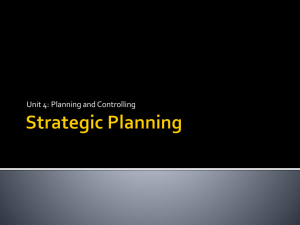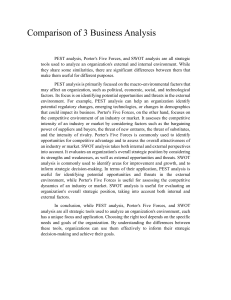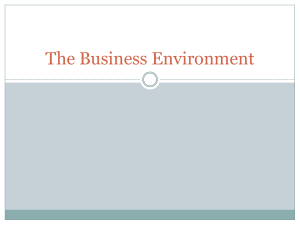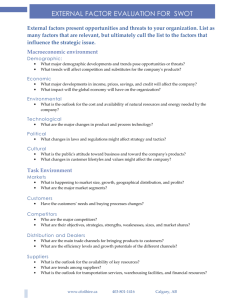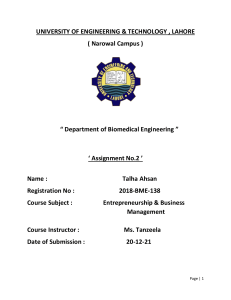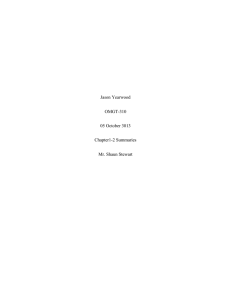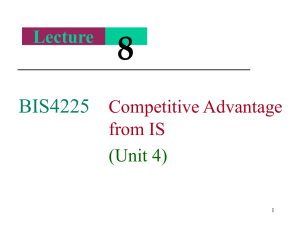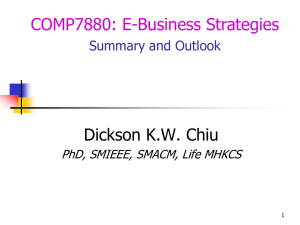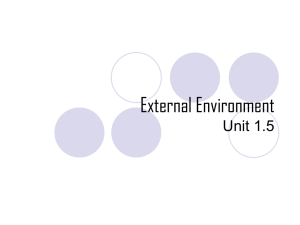3a. Strategic Planning pwpt
advertisement
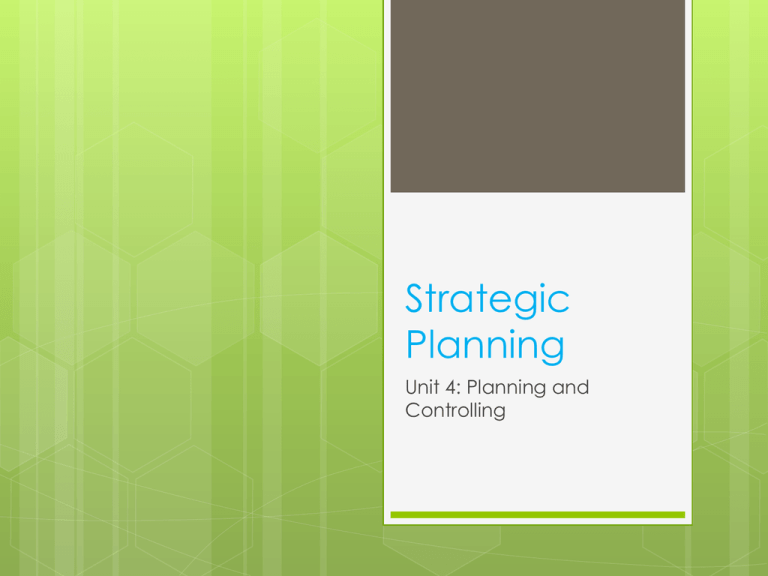
Strategic Planning Unit 4: Planning and Controlling Strategy Strategy - is a planned course of action undertaken to achieve the goals and objectives of an organization The overall strategy of an organization is known as corporate strategy But strategy may also be developed for any aspect of an organization's activities such as environmental management or manufacturing strategy A Strategic Plan A Strategic Plan - is a coordinated and systematic direction for an organization Strategic Planning determines where an organization is going and how it's going to get there In today’s highly competitive business environment, a solid Strategic Plan is essential to the success of a business The Strategic Planning Process 1. 2. 3. 4. 5. Identify Mission and Objectives Analyse Internal and External Environment Formulate Strategy Implement Strategy Evaluate Results and Control Management Tools for Analysis The second step of the process is to analyse the internal and external environment. There are three commonly used methods for doing this analysis: 1. SWOT Analysis 2. PEST Analysis 3. Porter’s 5 Forces Management Tools for Analysis: SWOT Analysis SWOT Analysis - includes both an internal analysis of organizational Strengths Weaknesses as well as an analysis of the external Opportunities Threats Successful organizations use their strengths to create strategies that take advantage of opportunities and minimize threats Management Tools for Analysis: PEST Analysis PEST Analysis is a tool to examine the external factors that provide opportunities and threats to an organization Political factors include: political stability, trade regulations, taxation, labour laws, and safety regulations Economic factors include: economic growth, stagnation, recession, interest rates, exchange rates, and inflation Social factors include: demographics and cultural aspects, e.g., health consciousness, population growth, age distribution, education, and attitudes to work and leisure Technological factors include: new discoveries and developments, rates of technological obsolescence, changes in information technology, and research and development activity Management Tools for Analysis: Porter’s Five Forces Porter's Five Forces - Incorporate strategies to meet opportunities and threats in the organization’s external environment Porter identifies five competitive forces that shape every industry and every market: Competitors are the existing competitive rivalry within the industry New entrants involve the threat from new market entrants Customers mean the bargaining power of buyers Suppliers are the bargaining power of suppliers Substitutes are the threat of substitute products which includes technology change Levels of Strategic Planning Large corporations have three levels of strategy that must all work together to accomplish the organization’s objectives: corporate, business, and functional Levels of Strategic Planning Strategy Level Description Main Question corporate Sets long-term direction for the organization as a whole, e.g., Cara Operations Ltd. In what industries and markets should we compete? business Each business unit or product line is often called a strategic business unit (SBU), e.g., Swiss Chalet, Harvey’s, Kelsey’s. How are we going to compete for customers in this industry and market? functional Each business unit has the How can we best utilize same basic functional areas or resources to implement departments, typically these our business strategy? include: human resources, marketing, production, finance, and information technology. Types of Strategic Plans 1. A Growth Strategy - involves expanding current operations One growth strategy is expanding in the same industry, e.g., Tim Horton’s opens more stores, all of them selling the same products This is called concentration Another growth strategy is vertical integration which means expansion by buying suppliers or distributors, e.g., a meat processing company buying farms (suppliers) or grocery stores (distributors) A third growth strategy is diversification which means buying or starting businesses in other industries Rogers Communications Inc. is an example of a diversified Canadian corporation Types of Strategic Plans 2. A Retrenchment Strategy - ,is used when an organization is in crisis It seeks to correct weaknesses by making changes to current business practices Restructuring and downsizing are two commonly used terms for retrenchment strategies Types of Strategic Plans An e-business Strategy - is the use of the Internet to become more successful Businesses can use Internet technology to buy materials from their suppliers and to sell products to their customers Even businesses who don’t sell goods or services online will use the Internet for advertising, collecting information, and distributing information 3. Your Task You will be split into 5 groups Read the case study assigned to your group As a group, discuss the answers to the questions included at the end of each case Decide on a format to present the results (and an overview of the case) of your work to your teacher and peers (slideshow, video, etc.) The presentation must present a brief introduction to the business and its situation, as well as answers to the questions. Be sure to use the concepts and terms you studied.
